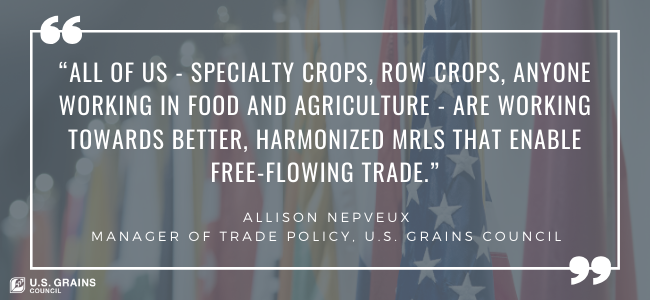Maximum residue levels (MRLs) are complicated but increasingly important to maintaining the flow of U.S. grain and co-products to international end-users. The U.S. Grains Council (USGC) joined the virtual 2020 MRL Harmonization Workshop for the first time in May 2020 to gain insight and build additional collaborations between the coarse grains and specialty crops industries in addressing these highly technical trade topics.
“Even though our considerations may be different, people were excited to see other industries involved in MRL issues,” said Allison Nepveux, USGC manager of trade policy, who presented during the workshop. “All of us – specialty crops, row crops, anyone working in food and agriculture – are working towards better, harmonized MRLs that enable free-flowing trade.”
By definition, a MRL is a regulatory standard that reflects both risk and hazard from exposure in a given environment, and then sets a scientific limit that reduces that risk well below any level that could be considered a health hazard. In other words, MRLs ensure food and feed products contain limited amounts of residue from crop protection products, at a level that varies depending on the specific product.
Internationally, crop protection companies are responsible for either submitting a MRL or an import tolerance – a similar residue level used when a substance is not used domestically but is important for imported products. Some countries adopt MRLs set by an external market or an international body like Codex Alimentarius (Codex). Others have their own national system through which they set their own MRLs.
When MRLs don’t match up or are missing, trade disruptions can and do occur. For example, a missing MRL in a country that defaults to Codex would mean that any residue detection above 0.00 would trigger a MRL violation until Codex can set and approve a MRL – a process that can take years.
Also – if a MRL is set to a different level than the exporting country, serious headaches can occur for global trade, particularly for bulk commodities. If a MRL is not aligned with either the U.S. MRL or international standards established by Codex, there is increased risk for rejected shipments or additional testing – both of which add costs.
The California Specialty Crops Council has organized this workshop for 15 years to address critically important issues like these related to MRLs. The timing of this workshop was important as international attention on MRLs has increased during the global COVID-19 pandemic.
“Attention on MRLs has not slowed down, it has accelerated and will continue to do so,” Nepveux said. “That was consistent from every group participating in this workshop. It’s becoming a bigger and bigger issue for everyone, not just us.”
While this meeting was organized by specialty crop groups, the workshop included participation from government, industry and other global stakeholders. The Council presented for the first time to provide the grain industry’s perspective on handling MRLs, including on the differences between how grains and other specialty crops move through the supply chain and the implications of certain international policies related to grains.
“Something that is unique to grains is how they are bulked and blended at every step along the way from being delivered to a country elevator to being loaded on a river barge,” Nepveux said. “The bulk commodity system is unique to grains – we cannot trace back to the farm, and a farmer does not know exactly where their corn will be delivered. As a result, when a country puts in a new MRL, we have to address those issues differently than farmers who grow specialty crops.”
Despite the difference between how specialty crops and coarse grains move through the U.S. export channels, the Council has taken inspiration and advice from how specialty crops track and monitor international developments in MRLs as the organization has become more involved in these discussions. That insight includes the need for a unified voice within the industry and transparent discussion when challenges arise.
“We can make better steps to collectively respond whenever we have issues or when there is an issue that might cross sectors,” Nepveux said. “We now have more relationships with some of the people working on the specialty crop side, so there is a better collaborative process that will come if we are working strategically on Codex or at the international level.”
About The U.S. Grains Council
The U.S. Grains Council develops export markets for U.S. barley, corn, sorghum and related products including distiller’s dried grains with solubles (DDGS) and ethanol. With full-time presence in 28 locations, the Council operates programs in more than 50 countries and the European Union. The Council believes exports are vital to global economic development and to U.S. agriculture’s profitability. Detailed information about the Council and its programs is online at www.grains.org.

